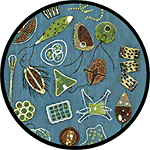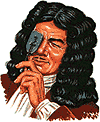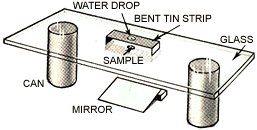


 The invention of the microscope is not credited to any one person. Strong lenses were used since antiquity to examine tiny objects. Microscopes were byproducts of research on telescopes by men such as Galileo and Kepler.
The invention of the microscope is not credited to any one person. Strong lenses were used since antiquity to examine tiny objects. Microscopes were byproducts of research on telescopes by men such as Galileo and Kepler.
One of the earliest uses of a simple microscope for examining the minute details of living things was by a Dutch cloth merchant, Anton van Leeuwenhoek (1632-1723). His microscope was very simple, but his skill at grinding lenses made it superior to many of the compound microscopes used previously. He was able to study the structure of tissue, and was one of the first scientists to discover protozoa in water. He also identified minute blood carrying  capillaries, helping to complete the anatomy of circulation. His microscopes (he constructed over 200) were considered superior to anything available in his day.
capillaries, helping to complete the anatomy of circulation. His microscopes (he constructed over 200) were considered superior to anything available in his day.
The demand for microscopes for scientific use grew rapidly during Leeuwenhoek's time. Improvements in design came rapidly. One of the first successful compound microscopes was built by another native of Holland, Zacharias Janssen, who was a maker of eyeglasses. His microscope had two lenses and was over 6 feet long. The basic design was refined further by scientists such as Robert Hooke, who was the first to supply a light source to the viewing area. By the middle of the 19th century microscope optics were just about perfected, and their basic design remains the same today.
Leeuwenhoek's microscope consisted simply of:
A) a screw for adjusting the height of the object being examined 
B) a metal plate serving as the body
C) a skewer to impale the object and rotate it
D) the lens itself, which was spherical
You can easily make a model based on Leeuwenhoek's microscope. A very simple one is built from only a paperclip. Straighten out the paperclip with a pair of pliers (small needle nose pliers work best for this project). Bend a small, complete loop in one end of the clip. The loop should be about 1/16 inch (1.5mm) across and as round as possible. Try not to heavily scratch the metal forming the loop. Rub a little oil or grease on the loop to give it a fine coating. Dip it in water (preferably distilled) and slowly remove it. A drop of water should form that will act as a lens. It is not nearly as strong as Leeuwenhoek's lenses, but it is the same spherical shape, and will magnify at about 2x or more.

A table top model can also be constructed, which is a little easier to use for small specimens. Cut a strip of metal about 4 inches by 1 inch (100mm x 25mm) from a metal food can or from sheet stock about the same thickness. File the edges if they are jagged or sharp. Place the metal strip on a piece of wood, and mark the exact center. Drill or punch a hole app. 1/16-inch (1.5mm) through this center mark. However you make this hole, keep in mind that it should be as round as possible, and that it should be clean and free from burs. The metal should not "pucker" around the hole, which can happen if it is punched. It is a good idea to polish around the hole with light grit paper to clean it up. Blow out any dust that remains afterwards.
 Bend the ends of the strip down to form a stand. Oil or grease around the hole as above, and, using a pencil, transfer a drop of water to the hole so that the drop remains in the hole. Place a small sheet of window glass on top of two cans, which are set at either end of the glass. Carefully place the metal strip on the center of the window glass, being careful not to dislodge the water drop "lens". Prop a small mirror under the glass so that light is reflected from it and up through the lens. Place whatever it is you want to examine beneath the lens (pollen, small insects, grains of salt or sand, etc.). Focus by gently pressing on the strip.
Bend the ends of the strip down to form a stand. Oil or grease around the hole as above, and, using a pencil, transfer a drop of water to the hole so that the drop remains in the hole. Place a small sheet of window glass on top of two cans, which are set at either end of the glass. Carefully place the metal strip on the center of the window glass, being careful not to dislodge the water drop "lens". Prop a small mirror under the glass so that light is reflected from it and up through the lens. Place whatever it is you want to examine beneath the lens (pollen, small insects, grains of salt or sand, etc.). Focus by gently pressing on the strip.
 You can make a more permanent lens from a small "penlight" light bulb (the type with a lens in the tip). Cut or break the lens part from the bulb, using pliers and being careful not to cut yourself. Chip off any pieces of the side of the bulb that remain. Using a drill, make the hole in the metal strip large enough to hold the lens, but not so large that it slips through. The lens should be seated with the round tip pointed downward. You can secure the lens in place with a tiny bit of epoxy. You can also epoxy it to the edge of the hole from the bottom, which will seal off the jagged edges. Use as little epoxy as you can get away with, and don't let any run onto the lens itself.
You can make a more permanent lens from a small "penlight" light bulb (the type with a lens in the tip). Cut or break the lens part from the bulb, using pliers and being careful not to cut yourself. Chip off any pieces of the side of the bulb that remain. Using a drill, make the hole in the metal strip large enough to hold the lens, but not so large that it slips through. The lens should be seated with the round tip pointed downward. You can secure the lens in place with a tiny bit of epoxy. You can also epoxy it to the edge of the hole from the bottom, which will seal off the jagged edges. Use as little epoxy as you can get away with, and don't let any run onto the lens itself.
Sal D'Ambra submits another type of lens made by drawing out a glass rod in a Bunsen flame, as shown in fig. A. The rod is then cut (when cool) as shown in B. The rod is then held vertically and fed into the flame to make a little ball on the end, which should be about 2-4 mm in diameter. This ball can now be used as a lens giving a magnification of 100 - 300 X depending on its size. To use the microscope the lens must be held almost in contact with the eye. A sample is held almost in contact with the lens as shown in fig. C.

If you are good at machining parts and grinding lenses, you can try your hand at constructing an actual replica of Leeuwenhoek's microscope, based on the drawing in the first section of this page. The device itself is simple. The most critical part is the lens, which should be mounted so that the distance from its center to the tip of the skewer is equal to the focal length. The original lenses varied in power, but were for the most part spherical. The best of his lenses were only 1 to 2mm in diameter. They can be made using the glass rod method, above. Although it is difficult to see in this illustration, the main body plate is actually two plates riveted together. The lens is sandwiched between, seated in holes in the plates, which are tapered so prevent it from falling out. The original instrument is all brass, except of course for the lens.
An excellent project based on the Leeuwenhoek microscope can be found at the Fun Science Gallery.

This article was printed from the Bizarre Labs website at bizarrelabs.com